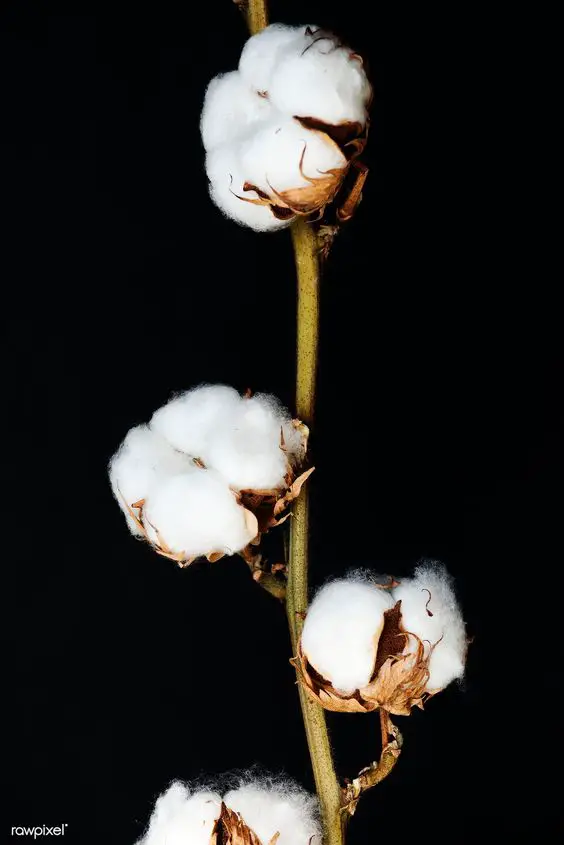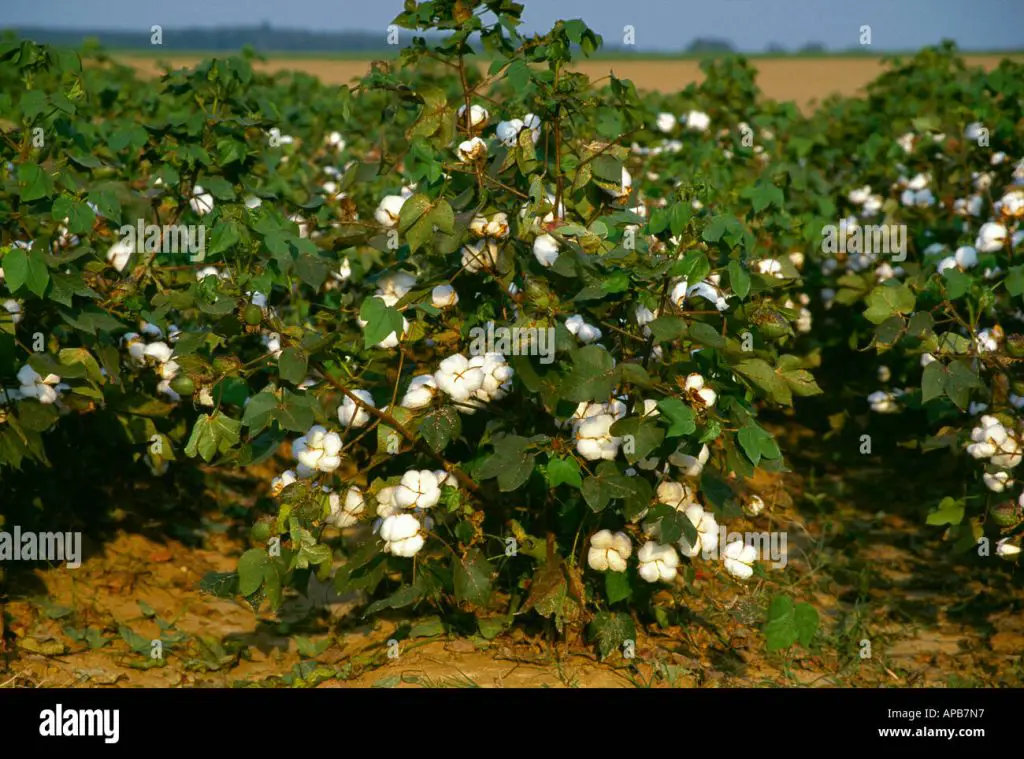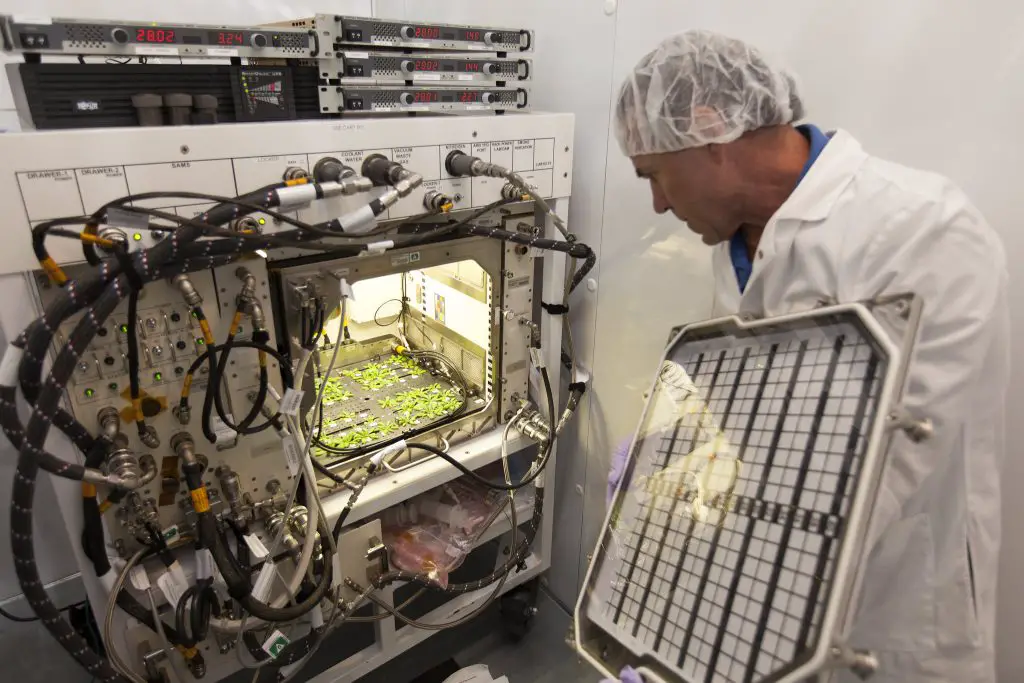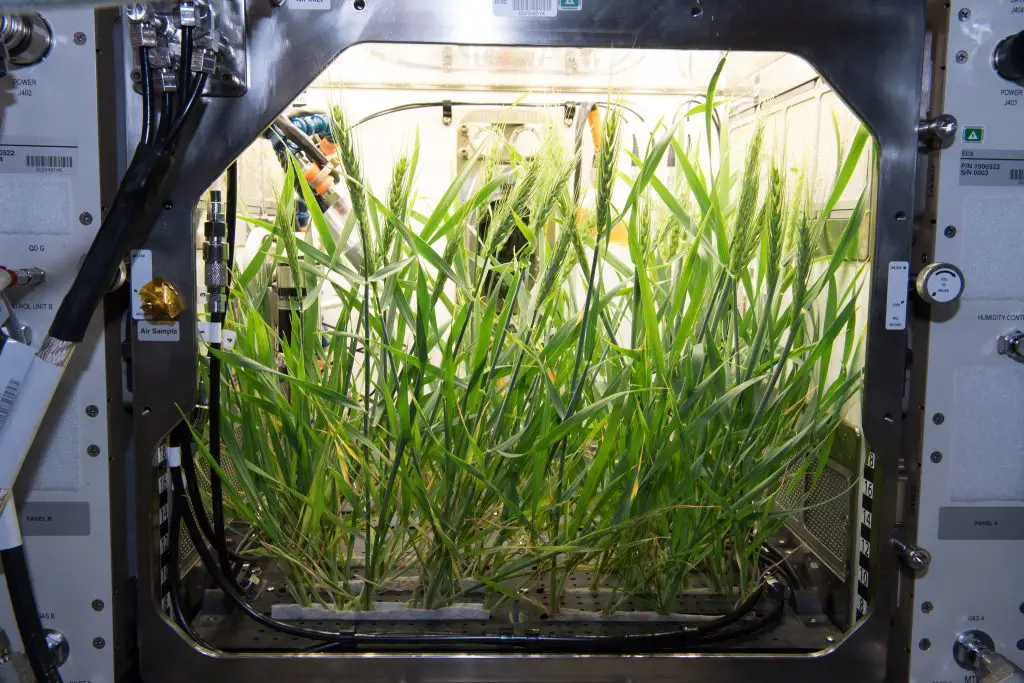A young cotton plant looks like a small, green seedling with two cotyledon leaves and a central stem. Introducing the appearance of a young cotton plant, it can be described as a small, green seedling with two cotyledon leaves and a central stem.
These cotyledon leaves, also known as seed leaves, are the first pair of leaves that emerge from the germinating seed. The cotyledons provide initial nourishment to the young plant until the true leaves start to develop. The central stem grows vertically from the cotyledon leaves, and it serves as the main axis for the plant’s future growth.

At this stage, the cotton plant may not display any blossoms or cotton bolls, as these typically occur later in its development. Understanding what a young cotton plant looks like is essential for farmers and gardeners to ensure proper care and cultivation throughout its growth cycle.
Characteristics Of A Young Cotton Plant
Young cotton plants have a distinct appearance and characteristics that differentiate them from mature ones. Understanding these early stages of cotton growth is essential for farmers and researchers alike. In this section, we will explore the key characteristics of a young cotton plant, including the appearance of the cotyledons, the development of true leaves, and the height and structure of the plant.
We will also touch upon the factors that influence the growth and appearance of young cotton plants, such as environmental conditions, nutrient availability, and pest and disease pressure.
Distinctive Features Of A Young Cotton Plant
- The appearance of the cotyledons:
- Cotyledons are the first leaves that emerge from a young cotton plant.
- They are usually oval-shaped and may vary in color, ranging from green to reddish-brown.
- Cotyledons play a vital role in providing initial nutrition to the plant until the true leaves take over.
- Development of the true leaves:
- After the cotyledons, the true leaves start to develop on a young cotton plant.
- True leaves are typically heart-shaped with a serrated margin.
- As the plant grows, it produces more true leaves, increasing its photosynthetic capacity.
- Height and structure of the plant:
- Young cotton plants initially have a low, compact structure.
- As they grow, the stem elongates, and branches start to develop.
- The overall height and structure of the plant depend on various factors, including genetics and environmental conditions.
Factors Influencing The Growth And Appearance Of Young Cotton Plants
- Environmental conditions:
- Temperature, humidity, and light exposure significantly impact the growth of young cotton plants.
- Cotton thrives in warm temperatures (around 75-85°f) with adequate sunlight for photosynthesis.
- Extreme temperatures, such as frost or heatwaves, can stunt growth or even damage the plant.
- Nutrient availability:
- Young cotton plants require a balanced supply of essential nutrients for healthy growth.
- Nitrogen, phosphorus, and potassium are crucial for overall plant development.
- Lack of nutrients can result in stunted growth, poor leaf coloration, and reduced yield potential.
- Pest and disease pressure:
- Cotton plants are vulnerable to various pests and diseases during their early stages.
- Insects like aphids, bollworms, and thrips can damage the young leaves, affecting plant growth.
- Fungal infections, such as damping-off or root rot, can also pose a threat to the health of young cotton plants.
Understanding the distinctive features and factors influencing the growth of young cotton plants is vital for successful cotton cultivation. By providing optimal environmental conditions, ensuring nutrient availability, and implementing effective pest and disease management strategies, farmers can maximize the potential of these young plants, leading to healthy growth and ultimately higher yields.
Identifying A Young Cotton Plant In The Field
Visual Cues For Recognizing A Young Cotton Plant:
Identifying a young cotton plant in the field is crucial for successful cotton farming. With their distinct leaf shape, stem color, and growth patterns, cotton plants can be easily recognized once you know what to look for. Here are some visual cues to help you identify a young cotton plant:
- Leaf shape and color: Young cotton plants have heart-shaped leaves with a slightly pointed tip. The leaves are vibrant green in color and have a smooth surface. As the plant grows, the leaves develop a serrated edge.
- Stem color and texture: The stems of young cotton plants are typically reddish or greenish in color. The stems are smooth and flexible, making them easy to distinguish from the woody stems of other crops.
- Presence of buds or flowers: Young cotton plants will not have any buds or flowers initially. As the plant matures, it starts producing buds, which eventually bloom into beautiful white or yellow flowers.
Differentiating Young Cotton Plants From Weeds Or Other Crops:
It’s important to differentiate young cotton plants from weeds or other crops to prevent any damage or competition for resources. Here are some key differences to help you distinguish between young cotton plants and common weed species:
- Key differences in leaf shape and arrangement: While young cotton plants have heart-shaped leaves, many weeds have narrow or elongated leaves or even alternate leaf arrangement. Pay attention to the leaf shape and arrangement to identify whether it’s a cotton plant or a weed.
- Growth patterns and structures unique to cotton plants: Cotton plants have a distinct growth habit. They grow in a sympodial manner, meaning the main stem grows upright with lateral branches developing in a spiral pattern. This unique growth pattern can help you differentiate cotton plants from other crops or weeds.
- Common weed species that may resemble cotton plants: Some common weed species such as pigweed or morning glory can resemble young cotton plants initially. However, weeds usually have different leaf shapes, growth habits, and texture. Understanding the characteristics of common weed species can aid in correctly identifying young cotton plants.
By recognizing the visual cues of a young cotton plant, as well as understanding the key differences between cotton plants and weeds or other crops, you can effectively identify and nurture your cotton plants for optimal growth and yield. Happy cotton farming!
Growth And Development Of Young Cotton Plants
Young cotton plants go through several stages of growth and development before reaching maturity. Understanding these stages is crucial for farmers and researchers alike. In this section, we will explore the different phases of growth in young cotton plants and how their appearance changes throughout these stages.
Let’s dive in and explore the fascinating journey of a cotton plant from its early days to its reproductive phase.
Overview Of The Stages Of Cotton Plant Growth
- Germination and emergence:
- Within a week of planting, the seed begins to germinate, absorbing water and breaking open.
- The emergence of the young cotton plant from the soil marks the beginning of its growth journey.
- Vegetative growth:
- During this stage, the cotton plant focuses on growing leaves and establishing a strong root system.
- The initial leaves are small, narrow, and heart-shaped, gradually expanding as the plant grows.
- Reproductive growth:
- Once the vegetative growth is established, the cotton plant transitions into the reproductive stage.
- Flower buds start to form, indicating the forthcoming development of cotton bolls.
Changes In Appearance Throughout The Growth Stages
- Expansion and lengthening of leaves:
- As the young cotton plant grows, its leaves expand and become broader, adopting the distinct shape we associate with mature cotton plants.
- Formation of vegetative branches:
- During the vegetative growth phase, the cotton plant produces side branches, resulting in a bushy appearance.
- Transition to reproductive structures:
- A notable change occurs when the cotton plant shifts its energy from leaf production to the formation of reproductive structures.
- Tiny flower buds develop, eventually opening and revealing the white petals of the cotton flower.
Observing these changes in appearance allows farmers to monitor the progress of their cotton plants throughout the growing season. By understanding the growth and development stages, farmers can make informed decisions about pest management, nutrient application, and irrigation. In the next sections, we will delve deeper into each stage, exploring the specific characteristics and requirements of young cotton plants as they progress towards maturity.
Common Challenges And Solutions For Young Cotton Plants
Young cotton plants require careful attention and proper maintenance for healthy growth. In this section, we will explore common challenges faced by young cotton plants and the best solutions to address them. By understanding potential issues affecting their growth and development, such as insect pests, diseases, and nutrient deficiencies, we can implement effective strategies for maintaining robust cotton plants.
Let’s delve into the details:
Potential Issues Affecting The Growth And Development Of Young Cotton Plants
- Insect pests and their damage:
- Cotton aphids: These tiny insects feed on the sap of young cotton plants, causing stunted growth and leaf curling. Regular scouting and early detection can help control their population.
- Bollworms: These caterpillars feed on cotton squares and bolls, leading to reduced yield and quality. Integrated pest management practices, including targeted pesticide application and beneficial insect conservation, can help manage their damage.
- Common diseases and their symptoms:
- Fusarium wilt: This fungal disease causes wilting, yellowing, and premature leaf drop in cotton plants. Crop rotation, resistant varieties, and proper sanitation can reduce its impact.
- Verticillium wilt: Another fungal disease that affects the vascular system of cotton plants, resulting in wilting, leaf chlorosis, and yield loss. Proper irrigation management and resistant cultivars can minimize its effects.
- Nutrient deficiencies or imbalances:
- Nitrogen deficiency: This deficiency leads to pale green or yellowing leaves and reduced growth. Applying nitrogen fertilizer at the right time can address this issue.
- Phosphorus deficiency: Low phosphorus levels can result in stunted growth and delayed maturity. Soil testing and targeted fertilization can help rectify this imbalance.
Best Practices For Maintaining Healthy Young Cotton Plants
- Integrated pest management strategies:
- Regular monitoring and early detection of pests.
- Utilization of biological controls and cultural practices to minimize chemical pesticide usage.
- Crop rotation to disrupt pest life cycles and reduce their buildup.
- Proper irrigation and fertilization techniques:
- Implementing a well-designed irrigation system to provide optimal water supply.
- Conducting regular soil testing to determine nutrient requirements.
- Timing fertilizer applications to match the crop’s needs.
- Timely weed control measures:
- Regular scouting and removal of weeds from the field.
- Integration of mechanical, cultural, and chemical weed control practices to reduce weed competition.
By addressing potential challenges through proactive measures and adopting best practices, we can ensure the healthy growth and development of young cotton plants. Implementing integrated pest management strategies, proper irrigation and fertilization techniques, and timely weed control measures will contribute to the successful cultivation of cotton crops.
Frequently Asked Questions For What Does A Young Cotton Plant Look Like
What Is The Appearance Of A Young Cotton Plant?
A young cotton plant typically has two cotyledon leaves and a main stem with small, green leaves. It also has a taproot that grows downward and secondary roots branching out horizontally. As it continues to grow, it develops more leaves and branches.
How Long Does It Take For A Cotton Plant To Reach Maturity?
On average, a cotton plant takes approximately 120 to 170 days to reach maturity, depending on the variety and environmental conditions. This includes the time from planting to when the cotton bolls are ready to be harvested.
What Are The Key Growth Stages Of A Cotton Plant?
The key growth stages of a cotton plant are: emergence (when it first breaks through the soil), seedling (initial leaves and stem development), squaring (formation of square buds), flowering (blooms and pollination), boll development (growth of cotton bolls), and maturation (bolls reach full size and open).
How Tall Does A Young Cotton Plant Grow?
A young cotton plant typically grows to a height of about 4 to 6 inches in the early stages. However, as it continues to grow, it can reach heights ranging from 3 to 6 feet or even taller, depending on the variety and growing conditions.
What Are Some Common Challenges In The Early Growth Of Cotton Plants?
Common challenges in the early growth of cotton plants include poor soil quality, pest attacks (such as aphids and thrips), diseases (like damping-off and root rot), unfavorable weather conditions (such as drought or excessive rainfall), and competition from weeds. Proper care and management can help overcome these challenges.
How Should I Care For Young Cotton Plants?
To care for young cotton plants, ensure they receive adequate sunlight, water, and nutrients. Monitor for pests and diseases, and take appropriate action if needed. Weed management is essential to reduce competition for resources. Regularly check soil moisture levels and adjust irrigation accordingly.
Consider using appropriate fertilizers as recommended based on soil testing.
Conclusion
To conclude, understanding the appearance of a young cotton plant is essential for successful cultivation. By recognizing its distinct characteristics, such as the small size, rounded leaves, and hairy stems, farmers and gardeners can ensure proper care and management. Starting from germination, the cotton plant goes through various growth stages, with each phase presenting unique attributes.
While it may be challenging to differentiate a young cotton plant from other similar plants, closely observing its features can help in accurate identification. Additionally, learning about the growth requirements, pest management, and harvesting techniques is crucial for maximizing the plant’s yield.
So, whether you’re a beginner or an experienced cultivator, familiarizing yourself with the appearance of a young cotton plant is a valuable skill that can contribute to a prosperous cotton farming journey.



